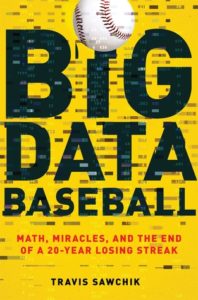Big Data Baseball by Travis Sawchik follows the story of the 2013 Pittsburgh Pirates. It gives insight into their sabermetrics approach and low budget salary to produce a winning baseball team for the first time in 20 years.
This story has been told before, about how a team overcomes some obstacle by thinking outside the box. The original was Moneyball. There have been numerous similar books written with each having emphasis on a particular team, league, statistic, etc.
 What makes Big Data Baseball unique is that it combines the human element with the “big data”. It tells the background of a few key characters, such as Clint Hurdle and Russell Martin. There is a plethora of name-dropping throughout the book, but these are two of the most prominent figures. Sawchick provides an inside look into how these people were before the Pirates and how they ended up fitting in with the Pirates qualitatively.
What makes Big Data Baseball unique is that it combines the human element with the “big data”. It tells the background of a few key characters, such as Clint Hurdle and Russell Martin. There is a plethora of name-dropping throughout the book, but these are two of the most prominent figures. Sawchick provides an inside look into how these people were before the Pirates and how they ended up fitting in with the Pirates qualitatively.
Some of the key components the Pirates implemented to win more games were defensive shifting both in the Majors and the minors. Many teams had already tried shifting, but the Pirates began doing it all the time and starting the instruction in Spring Training. Another strategy was to sign pitchers who threw low and implement sinkers and/or two-seam fastballs.
The Pirates have been at the bottom of the payroll tier for years. Thus, the allure of big name free agents eluded them. They simply couldn’t afford long-term nine-figure contracts. That is how they were able to sign players such as Martin and Francisco Liriano to relatively inexpensive and short-term contracts. By finding undervalued characteristics and skills, the Pirates created a contending team at minimum cost.
As in sports, data cannot completely predict any given outcome. Players get hurt, suspended, and perform below or above expectations. All of these happened to the Pirates in 2013 just as they happen to every team every season.
In Big Data Baseball, there is nothing new that makes it a must read for any sabermetrics fan. However, it is a blend of qualitative and quantitative data that makes it any intriguing read. Some books try to be completely one or the other, or they try to be as analytical as possible to garner expert status. Big Data Baseball shows Sawchik’s understanding of both the numbers and the people that those numbers represent.
 There was one repeated grammatical error that was the equivalent of swinging at a 3-0 fastball above your head. Sawchik discussed the bullpen. However, he wrote it as bullpen, bull pen, and bull-pen. All three spellings, not that far apart, were used. The correct spelling is of course “bullpen”. Aside from the five minutes of frustration, there wasn’t much to complain about with Big Data Baseball.
There was one repeated grammatical error that was the equivalent of swinging at a 3-0 fastball above your head. Sawchik discussed the bullpen. However, he wrote it as bullpen, bull pen, and bull-pen. All three spellings, not that far apart, were used. The correct spelling is of course “bullpen”. Aside from the five minutes of frustration, there wasn’t much to complain about with Big Data Baseball.
Any Pirates fan should be in line to read Big Data Baseball. There hadn’t been a winning baseball season in Pittsburgh in 20 years. And the story stands alone because of the turnover rate of rosters both for the Pirates and baseball in general. Even if the Pirates were to employ the same strategy for the next ten seasons, the results would be different each time based on internal and external changes and adjustments to planning. Despite the lack of ‘a wow’ factor, it is still a worthy read.

Leave a Reply